There’s more to Morocco than desert. Chris and Dee Finch tackled the Atlantic coast and mountain passes.
With autumn weather approaching, we couldn’t resist the lure of sunshine in Morocco – specifically, the Sahara and some spectacular passes over the Atlas mountains. We would get there as quickly as possible, taking the Portsmouth ferry to Bilbao, then a two-day blast across Spain to catch the ferry from Algeciras to Tangier.

We arrived at the new Tangier Med ferry terminal as dusk fell and headed out of the port for the 20-mile ride over the mountains in the pitch dark to our hotel at Fnideq.
As we were about to depart the next morning to Fes, I spotted the head of a nail in Dee’s rear tyre, probably picked up late the previous evening. The tyre had lost scarcely any pressure, so we decided to carry on — I would plug it on the roadside if necessary, and could get it properly repaired in Fes next day.
Enjoy everything MSL by reading the monthly magazine, Subscribe here.

It rained steadily between Fnideq and Tetouan, where the over-banding paintwork on the roads, especially on the many pedestrian crossings, was like wet glass. We continued into the rugged Rif Mountains and dropped down a steep descent to Chefchaouen. This known as the blue town because of its many blue painted houses in the medina. Around 1760 the ruling sultan ordered Jewish refugee families from Spain to move into the Medina, where they built their Andalusian-style dwellings. These Jews added indigo to the whitewash so that their houses contrasted with the traditional green of Islam.
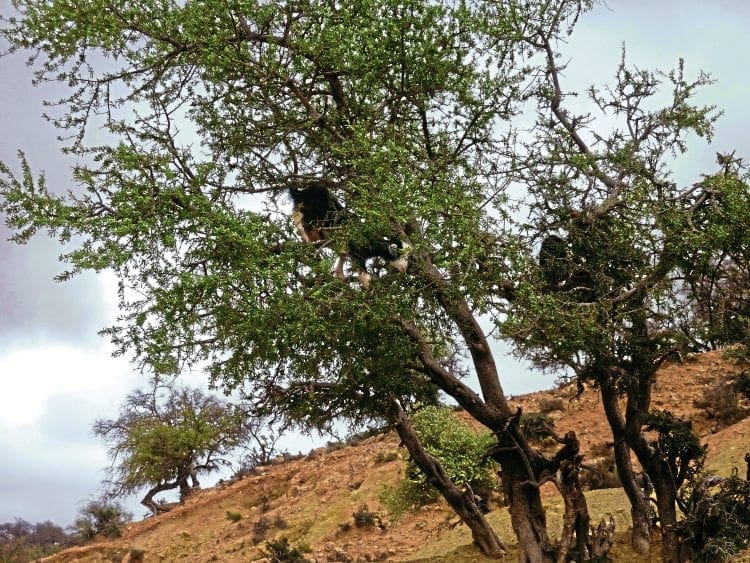
It was a good ride on to Fes, sticking to the N2 which weaves along high on the crests of the Rif Mountains, instead of the more obvious N13 route. It also runs through the heart of cannabis country, which although not as lawless as it once was, still has tales of travellers being flagged down by local kif sellers who try to pressurise them to buy their hash. Fes is the medieval capital of Morocco, the best-preserved old city in the Arab world, and its sprawling, labyrinthine medina of Fes el-Bali is the world’s largest car-free urban zone. I needed to take this opportunity to get Dee’s rear tyre repaired, and we soon spotted a tiny workshop with a pile of old car tyres outside on the pavement. Inside there was a tyre bead breaking machine so, in pidgin French, I explained that I wanted the tyre to be removed from the wheel and the inner surface of the tyre to be repaired with a special patch. He said that he didn’t have such a patch, but he would get one while I went back to the hotel to take the rear wheel out of the bike.
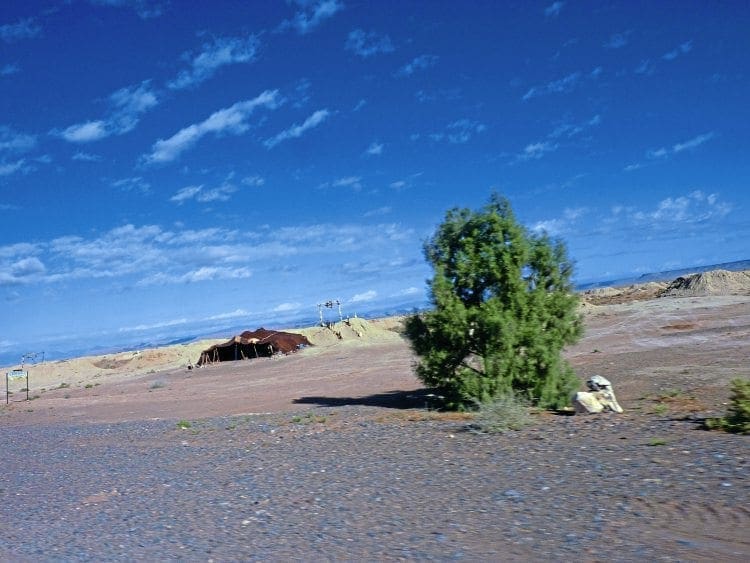
In the few minutes that it took me to do that, the man had indeed obtained the special patch. So far so good. As he started work, I watched over his shoulder and it was a good job that I did — he was about to lay the wheel on its side on his cobbled floor to take the tyre off with tyre levers. He had probably done this countless times with old steel car wheels, but was oblivious to the damage that he would have caused to the brake disc. I stopped him just in time, threw an old tyre from a nearby pile onto the cobbled floor and indicated that he should lay Dee’s wheel on top of that. After much back-patting and shaking of hands, it was a job well done and not expensive.
DESERT SKY
We had a long 250-mile ride from Fes south to Erfoud, dose to the Algerian border and on the edge of the Sahara Desert. We passed through the well-to-do town of Ifrane, with its green-tiled Royal Summer Palace and pseudo Alpine villas. To underline the fact that not all Morocco is the same, we carried on through verdant cedar forests which contrasted markedly with the barren landscape of the Middle Atlas. Further south still, having left the Middle Atlas behind us and ridden across a scrubland plain, the peaks of the High Atlas appeared ahead of us, the massive Jbel Ayachi range reaching 3737m.
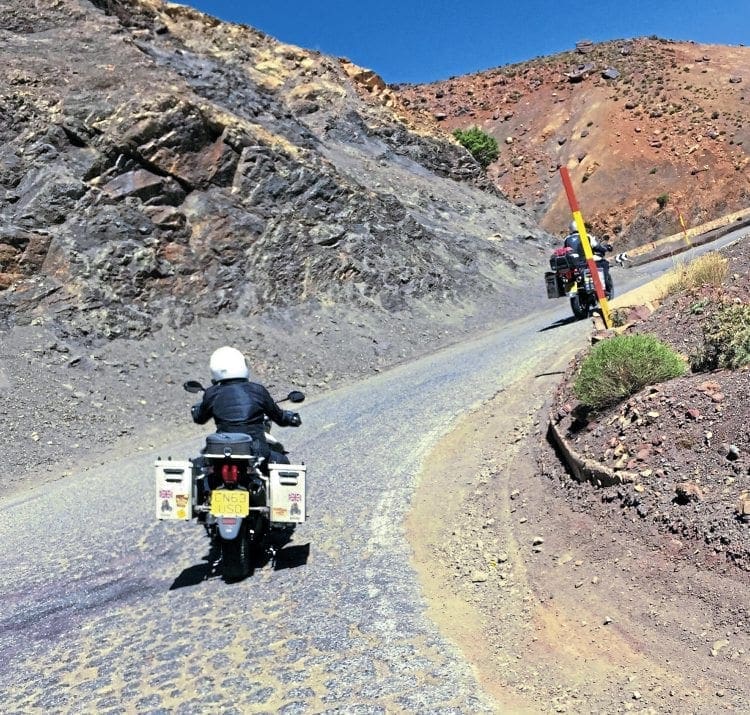
The next 100 miles from Midelt to Errachidia were an absolute delight to ride. The road twists through the Tizi n’ Tairhemt (Pass of the She-Camel) to around 1900m before descending again to the desert. Further south, we rode through the majestic Ziz Gorge, where the erosion of the rock has carved a pass through the mountains. This follows the Ziz Valley from the Tunnel du Légionnaire, built by the French in 1928, to the Barrage Hassan Addakhil, a large reservoir and dam constructed in 1971 to supply hydro-electric power and irrigation.
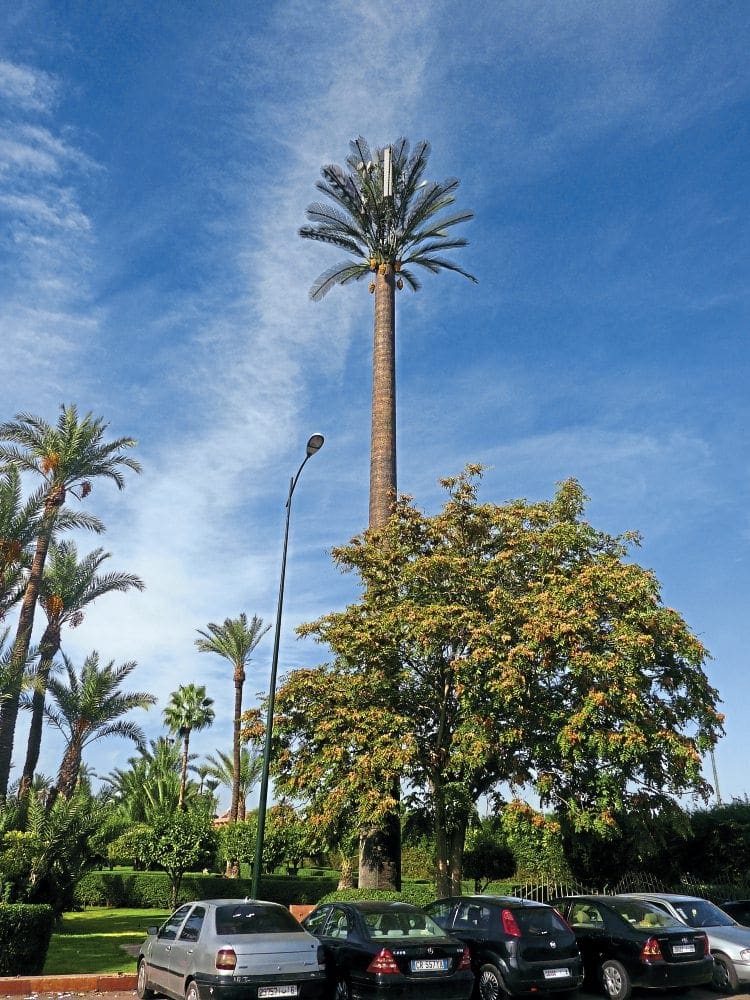
As we approached Erfoud in the late afternoon sun, we could begin to really appreciate the proximity of the Sahara, and later, from the flat roof of our hotel saw a spectacular desert sunset, followed by a magnificent night sky unaffected by light pollution. It was truly magical.
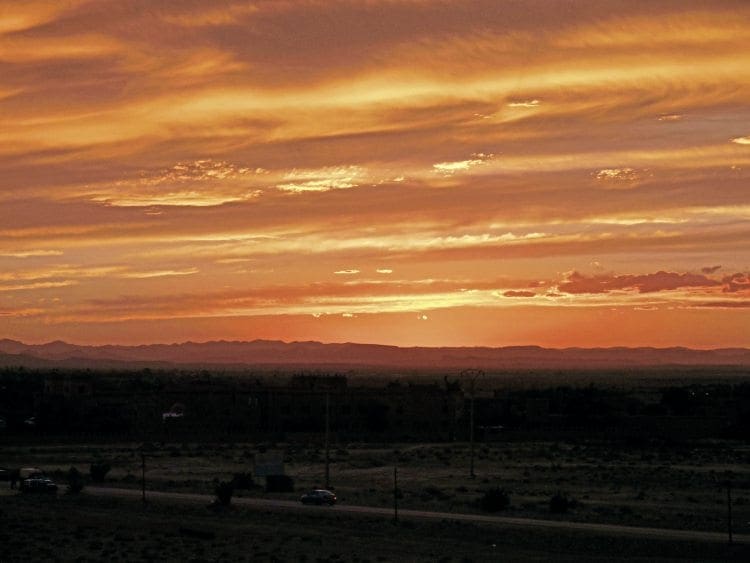
Next day, it was time to head west, on long straight roads across the desert with spectacular buttes and sculptured rocks on both sides of the road. Many of these strange shaped humps were actually man-made and were entries into old underground irrigation channels which took water from communal wells across the desert for long distances. We continued until we reached the lush palmery at Mellab, a town populated by descendants of the Alt Atta tribe, guerrilla fighters who opposed French occupation from the outset and who gave the French their hardest single battle in their quest to colonize Morocco.
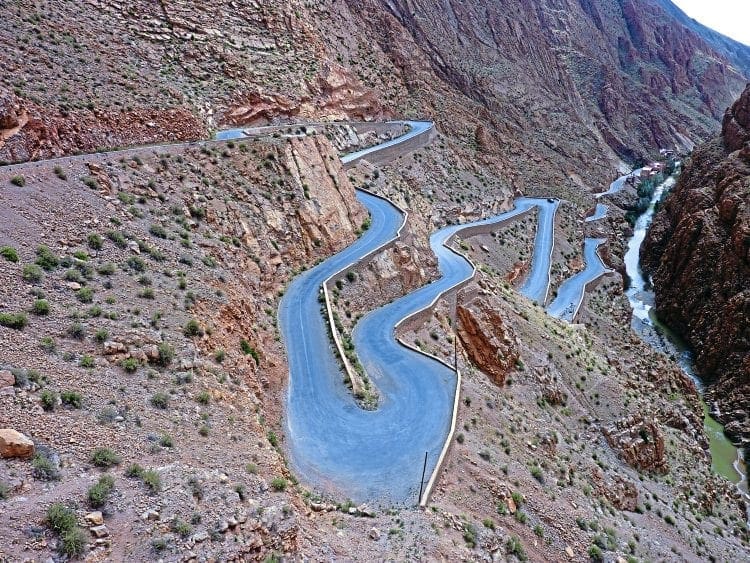
After a night in Tinghir we had an easier day in prospect – 125 miles to Marrakesh – but it did involve the Tizi n Ticha pass, which had very poor surface but is being improved. The downside was that we were held up by convoys of large, slow trucks hauling aggregate up the 2260m summit. To our delight, the surface was much better going down the other side of this winding mountain pass.

We spent most of the next day in the souks of Marrakesh, and the large meeting square where snake charmers mesmerise their cobras with flutes, monkeys perform acrobatics for the crowds and tooth pullers wield fearsome pincers.
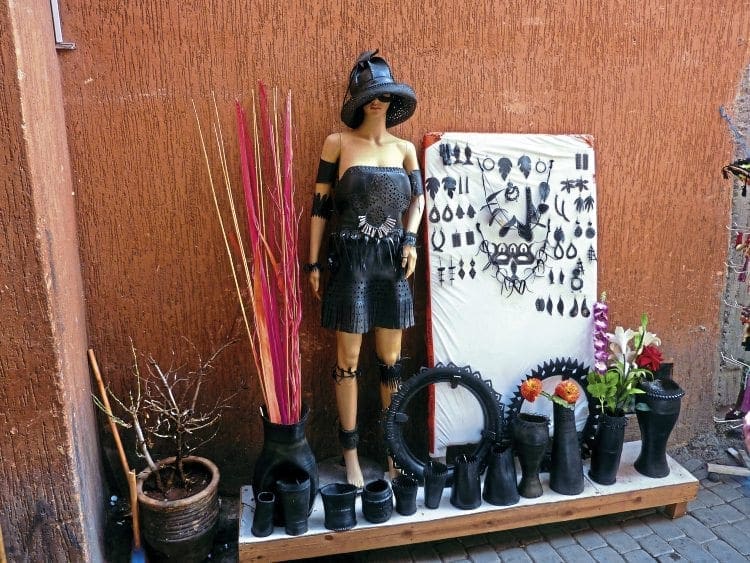
You can just forget time here. We wandered through the myriad of alleys and small squares to the many individual souks which seemed to specialise in specific crafts such as leather ware, woodcrafts, pottery, musical instruments, knives, hats, brightly printed silks, spices and even dominatrix rubber wear. Dee wanted to buy saffron, and the owner of a spice stall invited us to be seated while he produced all sorts of spices for us to sniff and examine, before eventually selling us 10g of the stuff.
LANDSLIDE JAM
The ride from Marrakesh to Agadir took us over the 2100m Tizi n’ Test pass. We knew to expect a very narrow and poorly surfaced winding road with precipitous drops, few if any, barriers, deep gravel in the road works and oncoming vehicles appearing around blind corners. And we were right. If tackling this pass it’s worth bearing in mind that it stretches for around 100 miles and once you’re on it, there is no alternative.

We soon arrived in the foothills and began our climb, stopping after about 60 miles at a small village where we had the de la menthe in a roadside cafe. The locals made us welcome and set out chairs for us beneath a covered outdoor area to keep us dry from the rain, which had just started. Back on the road, the downpour got worse and there was continuous evidence of rock falls onto the road from the steep mountains rising above us, as well as rivulets of water cascading down the mountainside and gushing across the road. The potholes were full of water, making it difficult to judge their depth, while the constant rain and misted visors didn’t help. We carried on through several flooded sections of road to the summit and stopped at a small cafe for hot coffee and lunch. It was now very cold and we were pleased to see that the cafe had a log fire — perfect for drying gloves.
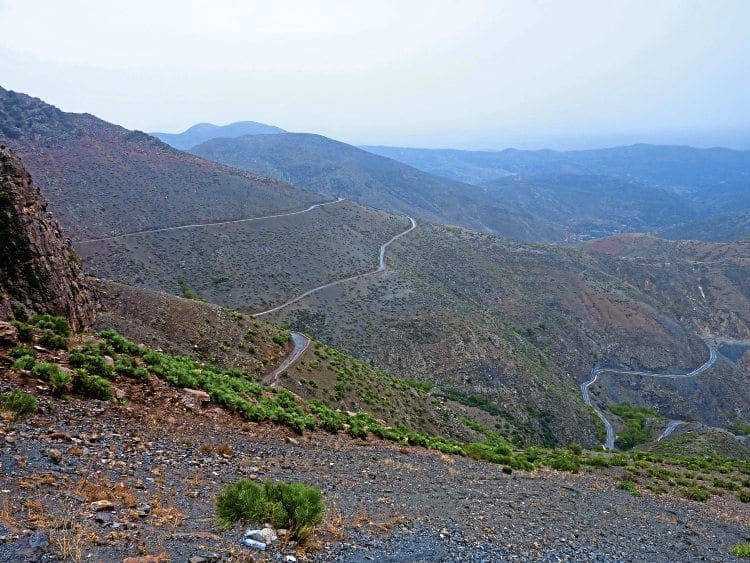
Once back on the bikes we started the descent, but after about a mile the road was completely blocked by a landslide. To compound the problem a single-decker bus, which had been coming up, had attempted to drive over the landslide and had stuck on its belly on top of the rubble. There was no possibility of getting past the bus on the landslip side by riding or pushing the bikes. Similarly, the back of the bus had slewed around and was just overhanging the edge of the mountain on the other side, where there was incidentally no barrier.
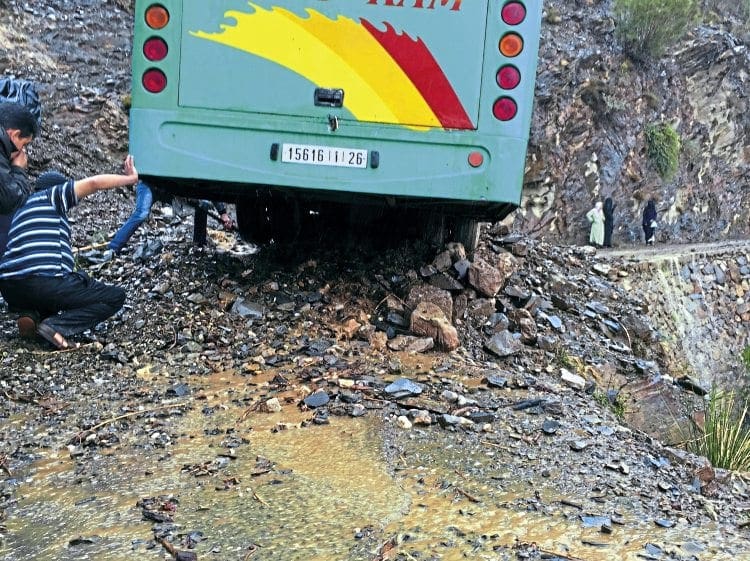
After about an hour the road clearing gang, who had been digging away at the rubble with spades, stopped digging. With the bus driver revving the engine and a whole bunch of people pushing on the rear of the bus, it slowly inched its way over the rubble. As soon as it was across, we jumped on our bikes and rode over the landslip before any of the other vehicles in the queue got stuck — at least we now had a clear road ahead of us!
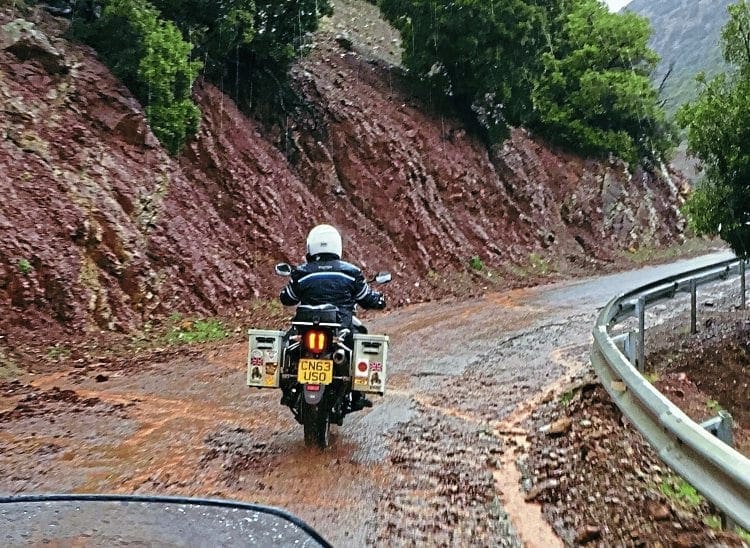
The irony was that we only had to ride for another quarter-of-a-mile past the landslide to where the beautifully repaired surface of the Tizi n’ Test began. We enjoyed the good road surface for a few miles and then, just as suddenly as it had started, the good tarmac gave way to a broken surface again. A couple of days later on the coast, we left Agadir in hot sunshine and cloudless skies and rode north with the glistening Atlantic close by on our left-hand side. This felt more like being on a European holiday than riding in Morocco. But as we rode north towards Essaouira, the sky became ominously dark and we started to encounter areas of significant flooding across the road and evidence of damage caused by high winds. Then, with just 10 miles to go, the rain really came down. The flooding visibly worsened, as rivulets of muddy water and stones gushed onto the road. At one point, we needed to cross a long concrete viaduct across a ravine, but the entire length of the bridge was about 8 to 10 inches deep with muddy water. I pulled over before crossing the bridge because a big truck was entering the bridge from the opposite end. I could envisage the inevitable consequence of this, so I waited and, sure enough, the truck made a huge bow-wave which would have rolled over us like a mini-tsunami!

After a stormy night, we awoke to find everywhere soaked, but although the sky was heavily overcast, it was not raining, which did bode well for our ride up to Casablanca. We made good time along straight roads for the first 60 or 70 miles and later stopped for lunch at a butcher’s stall. We bought fresh beef, carved directly from the carcass. The butcher then minced it, mixed it with chopped onions and herbs, and directed us to take it a few paces across the square to the ‘barbecue shop’. Here the owner formed the minced beef into small meatballs, added sliced onions and tomatoes, placed the food into a wire holder and then barbecued it to perfection over a long bed of hot charcoal. Straight off the barbecue and eaten with our fingers, it was delicious.

At Casablanca, we had to visit Rick’s Bar. Not the original one from the film of course — that was a Warner Bros set in Hollywood — but a replica. As you’d expect, there’s a piano tinkling out authentic 1940s and 50s tunes, and we enjoyed our food and wine to the strains of As Time Goes By.
Words & photography: Chris Finch
[googlemaps https://www.google.com/maps/d/embed?mid=1ehc8xTr1V_rcUJb0F2bf5M9J4A4&w=640&h=480]






